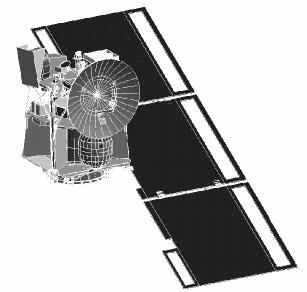 | |||||
|
 | |||||
|
Mars Climate Orbiter Configurations
ORBITER SPACECRAFT
The Mars Climate Orbiter spacecraft has four configurations: launch, cruise, aerobraking, and mapping. The launch configuration is shown in Figure 1. The solar arrays and high gain antenna (HGA) are stowed and locked to provide load paths for the acceleration forces experienced during launch. The launch mass is constrained to be no more than 643 kg (1,420 lbs), including fuel. The dry mass (without fuel) is 354 kg (780 lbs).
Shortly after launch and the injection onto a trans-Mars trajectory, the orbiter spacecraft will deploy its solar arrays and change its attitude to sun-pointing to recharge its batteries. It will fly in this configuration for about 3 to 5 days after launch until the telemetry indicates all is well with the spacecraft. At this point the spacecraft will change its on-board attitude control system to automatically keep the spacecraft on its proper trajectory. The cruise configuration is illustrated in Figure 2. Because the launch may put a small inaccuracy into the trajectory and since flying the spacecraft picks up small inaccuracies, the spacecraft will adjust the trajectory accordingly so it will get to Mars at the proper time and place to land. These adjustments are termed trajectory correction maneuvers (TCMs). Up to four TCMs are planned for the orbiter’s journey to Mars. TCMs will be performed in the cruise configuration. Figure 1. 1998 Mars Surveyor Orbiter Launch Configuration

Figure 2. 1998 Mars Surveyor Orbiter Cruise Configuration
Once the spacecraft gets to Mars, it has to slow down from its 5.9 km/s (13,200 mph) speed relative to Mars to its desired 29 hour orbit capture velocity of 4.7 km/s (10,510 mph) or less. This is accomplished by turning the orbiter spacecraft around so the engine is ahead of the spacecraft and in approximately the same direction as the orbiter is proceeding. Five minutes before Mars orbit insertion (MOI), the orbiter will open valves to fill the lines to the tanks with fuel and to pressurize the main propellant tanks, consisting of hydrazine fuel and a nitrogen tetroxide oxidizer, with Helium. (The oxidizer is needed because the main engine is a bipropellant engine; the oxidizer/hydrazine combination provides more thrust than a hydrazine-only engine.) The main engine burns for 16 to 17 minutes as it slows the spacecraft down to the 4.7 km/s (10,510 mph) speed that permits Mars’ gravity to hold it in the desired 29 hour orbit. After sensing there is no more oxidizer, valves will isolate the fuel tank and the oxidizer tank. At this point the oxidizer tank and the main engine have done their job and will not be needed again. The remaining hydrazine fuel will be used with the reaction control system (RCS) thrusters to keep the orbiter spacecraft in its proper orientation, to desaturate the reaction wheels, which are used to keep the spacecraft stable, and to perform maneuvers.After getting into a loose 29 hour elliptical capture orbit, the orbiter spacecraft will start aerobraking, using the planet’s atmosphere as a slow brake to circularize the orbit. Aerobraking was shown feasible on the Magellan spacecraft and allows us to build smaller, less expensive spacecraft with the tradeoff of using two to three months to get into our final circular orbit. This takes a slightly different attitude configuration of the spacecraft as is shown in Figure 3. Here the solar array is rotated around and put in a latch to hold it as it aerobrakes. The spacecraft then uses the large solar array area as an air brake. The spacecraft proceeds on its elliptical orbit dipping into the atmosphere at its lowest point (periapsis) and allowing the drag force of the atmosphere to slowly and slightly slow down the spacecraft each time it dips into the atmosphere. Since part of the spacecraft is exposed to the atmosphere during aerobraking, the exposed area of the spacecraft must be resistant to atmospheric atomic oxygen (a byproduct of the sun’s interaction with the upper CO2 atmosphere) and resistant to the slight heat pulse it receives each time it dips into the atmosphere (a maximum of 0.46 W/cm2 (3.0 W/ in2)). The total time it dips into the atmosphere is only a few minutes each time but it is sufficient to slow the spacecraft down from its initial capture orbit of 160 by 39,000 km (99 by 24,240 miles) to 90 by 405 km (56 by 252 miles). When the spacecraft gets down to this point, it uses its thrusters (using monomethyl hydrazine as fuel) to the orbit to a 405 km (252 miles) near-circular mapping orbit.
Figure 3. 1998 Mars Surveyor Orbiter Aerobraking Configuration
Once in its mapping orbit, the spacecraft deploys its high gain antenna and solar arrays into the mapping configuration shown in Figure 4. The first mission of the orbiter is to support the lander mission (3 Dec 99 to 8 Feb 00) by means of the UHF 2-way (command and return telemetry) relay link, a first for interplanetary spacecraft (Mars Global Surveyor flies a one-way, telemetry only UHF relay link). The orbiter overflies the lander for typically 5 - 6 minutes about 10 times a Martian day. During this brief time the lander communicates with the orbiter at high speed: 128,000 bits/second vs. 2,000 bits/second with conventional X-band telecommunications systems. Following completion of the lander surface mission, the orbiter will complete its one Martian year (1.8 Earth year) mission. After that , the instruments will be turned off and the orbiter allowed to drift in a low-maintenance orbit. Its final mission will be to act as a UHF 2-way relay for the ‘01 Mars mission, scheduled for arrival about January, 2002.
Figure 4. 1998 Mars Surveyor Orbiter Mapping Configuration
| Home | Mars Climate Orbiter | Mars Polar Lander | Deep Space 2 Microprobes |
| Welcome | Mailing List | Links | Credits |
For questions or comments on this website please refer to our list of contacts.